
Tetraodontidae is a family of primarily marine and estuarine fish of the order Tetraodontiformes. The family includes many familiar species variously called pufferfish, puffers, balloonfish, blowfish, blowers, blowies, bubblefish, globefish, swellfish, toadfish, toadies, toadle, honey toads, sugar toads, and sea squab. They are morphologically similar to the closely related porcupinefish, which have large external spines.

The Chesapeake Bay is the largest estuary in the United States. The Bay is located in the Mid-Atlantic region and is primarily separated from the Atlantic Ocean by the Delmarva Peninsula, including parts of the Eastern Shore of Maryland, the Eastern Shore of Virginia, and the state of Delaware. The mouth of the Bay at its southern point is located between Cape Henry and Cape Charles. With its northern portion in Maryland and the southern part in Virginia, the Chesapeake Bay is a very important feature for the ecology and economy of those two states, as well as others surrounding within its watershed. More than 150 major rivers and streams flow into the Bay's 64,299-square-mile (166,534 km2) drainage basin, which covers parts of six states and all of Washington, D.C.

Raritan Bay is a bay located at the southern portion of Lower New York Bay between the U.S. states of New York and New Jersey and is part of the New York Bight. The bay is bounded on the northwest by New York's Staten Island, on the west by Perth Amboy, New Jersey, on the south by the Raritan Bayshore communities in the New Jersey counties of Middlesex and Monmouth, and on the east by Sandy Hook Bay. The bay is named after the Raritans, a branch of the Lenape tribe who lived in the vicinity of the bay and its river for thousands of years, prior to the arrival of Dutch and English colonists in the 17th century.
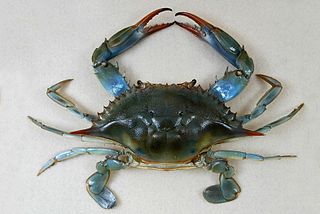
Callinectes sapidus, the blue crab, Atlantic blue crab, or, regionally, the Maryland blue crab, is a species of crab native to the waters of the western Atlantic Ocean and the Gulf of Mexico, and introduced internationally.

The king mackerelsurmayi or kingfish, is a migratory species of mackerel of the western Atlantic Ocean and Gulf of Mexico. It is an important species to both the commercial and recreational fishing industries.

The narrow-lined pufferfish or striped puffer is a demersal marine fish belonging to the family Tetraodontidae.
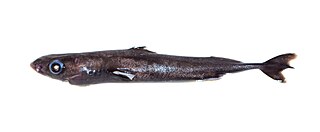
The smalleye pygmy shark is a little-known species of squaliform shark in the family Dalatiidae, found in water 150–2,000 m (490–6,560 ft) deep near Japan, the Philippines, and Australia. It migrates vertically daily, spending the day in deep water and the night in shallower water. One of the smallest shark species, the smalleye pygmy shark is known to reach only 22 cm (8.7 in) long. It has a blackish, spindle-shaped body with relatively small eyes, and a spine preceding the first dorsal fin, but not the second. Bioluminescent photophores occur on its underside, which may serve to disguise its silhouette from predators. This species feeds on small squid, krill, shrimp, and bony fishes. It is aplacental viviparous. The International Union for Conservation of Nature has assessed it as Least Concern, citing its wide distribution and lack of threat from fisheries.

The sharptooth houndshark or spotted gully shark is a species of houndshark in the family Triakidae found in shallow inshore waters from southern Angola to South Africa. Favoring sandy areas near rocky reefs and gullies, it is an active-swimming species that usually stays close to the bottom. This robust shark reaches 1.7 m (5.6 ft) in length and has characteristically large, rounded fins; the pectoral fins in particular are broad and sickle-shaped in adults. It also has a short, blunt snout and long furrows around its mouth. This species is gray or bronze in color above, with variable amounts of black spotting.
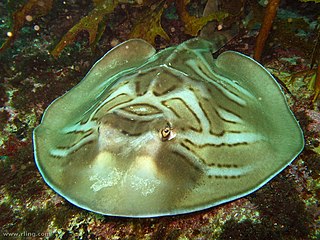
Trygonorrhina, also known as the fiddler rays or banjo rays, is a genus of guitarfish, family Rhinobatidae. The two species are found along the eastern and southern coasts of Australia. They are benthic in nature, favoring shallow, sandy bays, rocky reefs, and seagrass beds. The eastern fiddler is found to a length of 120 cm and the southern fiddler to a length of 180 cm.

The grey triggerfish, or gray triggerfish, is a species of ray-finned fish in the triggerfish family. The species is native to shallow parts of the western Atlantic from Nova Scotia to Argentina and also the eastern Atlantic, the Mediterranean Sea and off Angola on the west coast of Africa.

Great Bay is located in southern New Jersey's Atlantic Coastal Plain in Ocean and Atlantic Counties, about ten miles (16 km) north of Atlantic City and is about 5.5 miles northwest of Brigantine, and 5.5 miles southwest of Beach Haven. The Mullica River flows into the bay, and together they form the Mullica River - Great Bay estuary habitat. The bay is connected to the Atlantic Ocean via the Little Egg Inlet. Great Bay is considered one of the least-disturbed marine wetlands habitats in the northeastern United States.

The long-spine porcupinefish, also known as the freckled porcupinefish, porcupine puffer, and porcupine pufferfish, is a species of marine fish in the family Diodontidae.
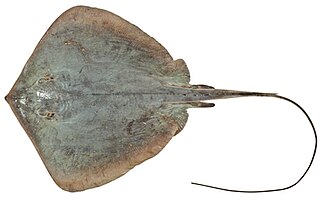
The estuary stingray, also called the estuary stingaree or brown stingray, is a species of stingray in the family Dasyatidae. Endemic to eastern Australia, it typically inhabits shallow, mangrove-lined tidal rivers, estuaries, and bays in southern Queensland and New South Wales. This yellow-brown to olive ray grows to at least 93 cm (37 in) across. It has a diamond-shaped pectoral fin disc and a mostly smooth, whip-like tail bearing both dorsal and ventral fin folds. It can additionally be identified by its long, narrow nostrils and the row of thorns along the midline of its back.

The checkered puffer is a species in the family Tetraodontidae, or pufferfishes.

Least puffer is a species in the family Tetraodontidae, or pufferfishes. This species is the common bay and inshore puffer for the waters around Texas and Louisiana. It has also been found as far east as Apalachicola Bay and south to Yucatán. Mature least puffers are small, usually less than four inches (100 mm).

Canthigaster rostrata, commonly known as the Caribbean sharp-nose puffer, is a pufferfish from the Western Central Atlantic. The Caribbean sharp-nose puffer is a small fish with a maximum length of 12 cm or approximately 4.7 inches. It can be encountered from the coast of South Carolina to Venezuela, including Bermuda, the Gulf of Mexico, and in the Caribbean Sea. They can live up to 10 years in the wild, females typically live longer due to aggressive male territory behavior. The Caribbean sharp-nose puffer is a highly toxic species of marine fish due to the presence of tetrodotoxin in its tissues and organs. Despite its toxicity, the sharp-nose pufferfish occasionally makes its way into the aquarium trade.

Coastal fish, also called inshore fish or neritic fish, inhabit the sea between the shoreline and the edge of the continental shelf. Since the continental shelf is usually less than 200 metres (660 ft) deep, it follows that pelagic coastal fish are generally epipelagic fish, inhabiting the sunlit epipelagic zone. Coastal fish can be contrasted with oceanic fish or offshore fish, which inhabit the deep seas beyond the continental shelves.
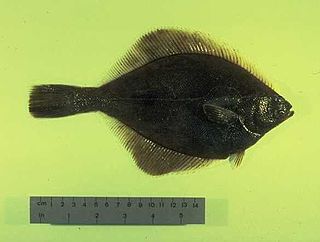
The yellowfin sole is a flatfish of the family Pleuronectidae. It is a demersal fish that lives on soft, sandy bottoms at depths of up to 700 metres (2,300 ft), though it is most commonly found at depths of around 91 metres (299 ft). Its native habitat is the temperate waters of the northern Pacific, from Korea and the Sea of Japan to the Sea of Okhotsk, the Bering Sea and Barkley Sound on the west coast of Canada. Males grow up to 49 cm (19 in) in length, though the common length is around 33.5 cm (13.2 in). The maximum recorded weight is 1.7 kg (3.7 lb), and the maximum recorded lifespan is 26 years.

Sphoeroides annulatus is a species in the family Tetraodontidae, or pufferfishes. It is found in the eastern Pacific Ocean from California, USA to Pisco, Peru and the Galápagos Islands.

The Pacific spiny lumpsucker is a species of bony fish in the family Cyclopteridae.





















